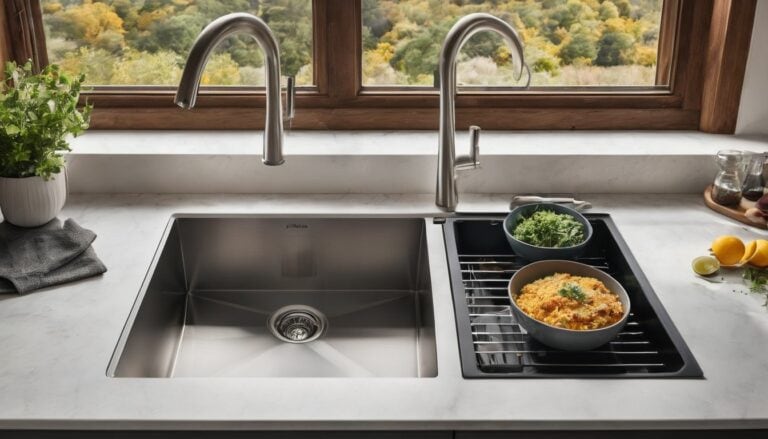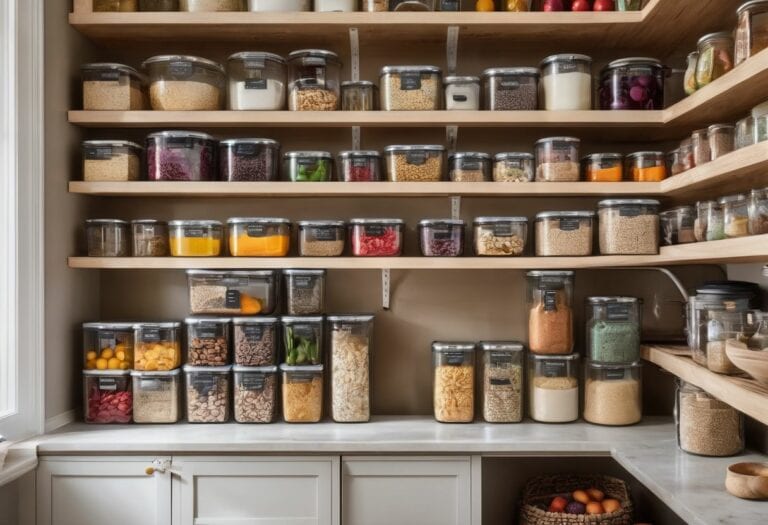Can You Paint a Porcelain Sink? Step-by-Step Guide!
Tired of staring at your outdated porcelain kitchen sink? Looking for an affordable way to give your old paint a fresh new look? Consider starting a painting project and use a cleaner to prep the surface before applying epoxy paint.
Painting your porcelain sink might just be the solution you’ve been searching for to remove hard water stains in your bathroom. Using a cleaner to wash the sink before painting can help achieve better results.
Can you paint a porcelain kitchen sink?
The answer is Yes! But before you reply, grab that tub of bleach and vinegar and let’s dive into everything you need to know about this process. From preparation to choosing the right type of paint, we’ve got you covered. If you have any questions or need further assistance, please don’t hesitate to reply. Now let’s get straight to the details.
Factors that Determine Whether You Can Paint a Porcelain Sink Or Not

Before you embark on a painting project for your porcelain sink, it’s important to understand the factors that determine whether you should do it or not. This applies whether you are painting a porcelain tub or a porcelain sink. The condition and type of porcelain are crucial considerations.
Considerations for the Condition and Type of Porcelain
When deciding whether to paint your porcelain sink, carefully evaluate its condition. If there are any chips or cracks present, painting may not be the best solution as these imperfections can affect the final results. It’s important to note that even with proper preparation and application techniques, painted surfaces can still chip or peel over time due to regular use and exposure to water.
Furthermore, consider the type of porcelain used in your sink. Glossy finishes tend to be more challenging to paint because they don’t provide much texture for the paint to adhere to. On the other hand, matte finishes offer better adhesion and may yield more satisfactory results when painted.
Alternative Options if Painting is Not Feasible
If painting isn’t feasible for your porcelain sink due to its condition or type, there are alternative options you can explore:
- Refinishing: Instead of painting, you could consider refinishing your sink using specialized kits designed for this purpose. Refinishing involves applying a new coating over the existing surface to restore its appearance.
- Replacement: If your sink is beyond repair or you’re looking for a completely different design, replacing it might be the best course of action. This allows you to choose from various styles and materials that suit your preferences and needs.
Common Challenges when Painting Porcelain Sinks
Painting porcelain sinks can pose certain challenges that you should be aware of:
- Adhesion: Ensuring proper adhesion between the paint and the glossy surface of a porcelain sink can be difficult. It’s crucial to thoroughly clean and prepare the surface before applying any paint.
- Durability: Painted surfaces on porcelain sinks may not be as durable as the original finish. Regular use, exposure to water, and cleaning agents can cause the paint to chip or peel over time.
- Maintenance: Painted surfaces require regular maintenance to preserve their appearance. Avoid using abrasive cleaners or scrubbing too vigorously, as these actions can damage the painted surface.
Steps to Paint a Porcelain Sink
If you’re wondering whether you can paint a porcelain kitchen sink, the answer is yes! Follow these step-by-step instructions to successfully transform your old, worn-out sink into a stunning focal point of your kitchen. Painting a porcelain sink can be a cost-effective way to give it a fresh new look without the need for an expensive replacement.
Prepare Materials
Before diving into the painting process, gather all the necessary materials. Here’s what you’ll need:
- Mild abrasive cleaner
- Sandpaper (fine-grit)
- Primer designed for use on porcelain surfaces
- Epoxy-based paint suitable for sinks
- High-quality brushes or foam rollers
- Painter’s tape
- Drop cloths or plastic sheets
Types of Paint To Consider
When it comes to painting a porcelain sink, not just any paint will do. Not all paints adhere well to porcelain. The type of paint you choose can significantly impact the durability and finish of your project. Specialized paints like epoxy, acrylic, and enamel are generally recommended for this type of project. Each has its own set of pros and cons. Here are some types of paint that are generally recommended for porcelain surfaces and their pros and cons:
Enamel Paint
- Pros: Offers a hard, glossy finish that is highly durable.
- Cons: Takes longer to dry and may require a clear coat for added protection.
Epoxy Paint
- Pros: Extremely durable and provides excellent adhesion. It’s also resistant to chemicals, making it a good choice for kitchen sinks.
- Cons: Mixing is required, and it has a strong odor. Proper ventilation is essential during application.
Acrylic Paint
- Pros: Quick-drying and offers a wide range of colors.
- Cons: Less durable than enamel or epoxy and may require multiple coats for full coverage.
Brands to Consider
Choosing a reliable brand can make a world of difference in the quality and longevity of your paint job. Here are some brands known for their high-quality paints suitable for porcelain:
- Rust-Oleum: Known for its durable and versatile epoxy paints.
- Krylon: Offers a range of enamel and acrylic paints suitable for various surfaces, including porcelain.
- Valspar: Provides high-quality enamel paints that are easy to use and offer a great finish.
- Benjamin Moore: Known for its premium quality paints, including some suitable for porcelain surfaces.
Choosing the right type of paint and brand is crucial for the success of your porcelain sink painting project.
Take Precautions and Ensure Proper Ventilation
Painting a porcelain sink requires taking certain precautions to ensure safety and achieve optimal results. Make sure you have proper ventilation in your workspace by opening windows or using fans. It’s also crucial to wear protective gear such as gloves and goggles to shield yourself from any chemicals or fumes.
Clean and Prep the Sink Surface
Start by thoroughly cleaning the sink with a mild abrasive cleaner to remove any dirt, grime, or soap scum. Rinse it well and allow it to dry completely before proceeding. Next, lightly sand the surface of the sink using fine-grit sandpaper. This step helps create a rough texture that allows the primer and paint to adhere better.
Apply Primer
Priming is an essential step in achieving long-lasting results when painting a porcelain sink. Use a primer specifically formulated for use on porcelain surfaces. Apply an even coat of primer using high-quality brushes or foam rollers, ensuring complete coverage over every inch of the sink’s surface. Allow the primer to dry according to the manufacturer’s instructions.
Paint Your Sink
Once the primer is fully dry, it’s time to paint your sink. Choose an epoxy-based paint that is specifically designed for sinks to ensure durability and resistance to water and stains. Apply the paint in thin, even coats, using smooth brush strokes or a foam roller. Allow each coat to dry completely before applying the next one. Depending on the desired color and finish, you may need multiple coats of paint.
Seal the Paint
To protect your newly painted porcelain sink from daily wear and tear, it’s essential to apply a clear sealant as a final step. The sealant adds an extra layer of protection and helps prolong the life of the paint job. Follow the manufacturer’s instructions for application and drying time.
By following these tried-and-tested steps, you can achieve professional-looking results when painting your porcelain kitchen sink. Remember to take proper precautions, have adequate ventilation, and use high-quality materials for a successful project.
Preparing and Sanding the Surface
To ensure a successful paint job on your porcelain kitchen sink, proper preparation is key. Before you can dive into transforming your sink with a fresh coat of paint, there are a few essential steps you need to take to prepare and sand the surface.
Clean and Degrease Thoroughly
Before you start sanding, it’s crucial to clean and degrease your porcelain sink thoroughly. Any dirt, grease, or grime on the surface can prevent the paint from adhering properly. Use a mild detergent or cleaner specifically designed for porcelain surfaces. Scrub the entire sink using a soft brush or sponge to remove any traces of dirt or grease. Rinse it thoroughly with water and make sure all cleaning agents are completely removed.
Create an Ideal Surface
To create an ideal surface for paint adhesion, you’ll need to use fine-grit sandpaper. Gently sand the entire surface of the sink in circular motions. This will help roughen up the smooth porcelain finish, allowing the primer and paint to adhere better. Be sure to cover every inch of the sink, including corners and edges.
Remove Imperfections
Sanding also allows you to remove any existing chips or imperfections on the surface of your sink. By carefully sanding these areas, you can smooth them out and create an even surface for painting. Pay close attention to any scratches or chips that may be present in your sink.
Smoothness is Key
As you sand, make sure that all areas are smooth, clean, and ready for priming. Run your hand across the surface after sanding to check for any rough spots or inconsistencies. If necessary, go over those areas again until they feel smooth to the touch.
Dust Off
After completing the sanding process, it’s important to dust off any residue left behind by the sandpaper. Use a soft cloth or brush to remove any loose dust or powder from the surface. This will ensure that your primer and paint adhere properly without any interference.
Properly preparing and sanding the surface of your porcelain sink is crucial for achieving a professional-looking finish. By following these steps, you’ll create an ideal foundation for the paint to adhere to, ensuring a long-lasting and beautiful transformation.
Applying Bonding Agent and Primer

To ensure a successful paint job on your porcelain kitchen sink, it’s crucial to apply a bonding agent and primer. These two steps will create a strong foundation for long-lasting paint adherence. Let’s dive into the details:
Apply a Bonding Agent Specifically Designed for Use on Porcelain Surfaces
Before you start painting, it’s essential to apply a bonding agent that is specifically designed for use on porcelain surfaces. This bonding agent helps the paint adhere properly to the sink, ensuring durability and longevity. Make sure to follow the manufacturer’s instructions when applying the bonding agent.
Here are some key points to remember:
- Clean the sink thoroughly with vinegar or another recommended cleaner before applying the bonding agent.
- Use a brush or roller to evenly apply the bonding agent onto the surface of the sink.
- Allow sufficient drying time as per the manufacturer’s guidelines before moving on to the next step.
Use Primer Formulated for High Adhesion to Enhance Paint Durability on Sinks
After applying the bonding agent, it’s time to use a primer formulated for high adhesion. The primer acts as an additional layer of protection and enhances paint durability on sinks. It provides better coverage and ensures that your painted sink withstands daily use.
Consider these tips when using primer:
- Choose an epoxy-based primer that is suitable for porcelain surfaces.
- Apply an even coat of primer using a brush or roller, covering all areas of the sink.
- Allow ample drying time between applying each layer of primer.
By using both a bonding agent and high-adhesion primer, you’re creating optimal conditions for successful painting results. These products work together to bond with the porcelain surface, ensuring that your painted sink stands up against wear and tear.
Remember, proper application techniques are vital in achieving long-lasting paint adherence on your kitchen sink. Take your time during this process, allowing each layer to dry completely before proceeding to the next step.
Painting Techniques for a Porcelain Sink
To achieve a beautifully painted porcelain kitchen sink, it’s important to employ the right techniques. By following these tips, you can transform your vintage porcelain sink into a stunning focal point in your kitchen.
Paint using even strokes in one direction for consistent coverage on your sink’s surface.
When painting a porcelain sink, it’s crucial to apply the paint evenly and consistently. Use smooth and deliberate strokes in one direction to ensure uniform coverage across the entire surface. This technique helps prevent streaks or uneven patches on your sink.
Avoid excessive layering by applying thin coats of enamel or epoxy-based paints.
To achieve a professional-looking finish, it’s best to apply multiple thin coats of paint rather than thick layers. Thin coats allow for better adhesion and drying between each application, resulting in a smoother and more durable finish. Enamel or epoxy-based paints are ideal choices for painting porcelain sinks due to their durability and resistance to water and stains.
Incorporate decorative techniques like stenciling or color blocking for a personalized touch.
If you want to add some personality to your painted porcelain sink, consider incorporating decorative techniques such as stenciling or color blocking. Stenciling allows you to create intricate patterns or designs on your sink’s surface, while color blocking involves using contrasting colors to create visually appealing sections. These techniques can give your sink a unique and personalized look that reflects your style.
Consider using spray paint for a smoother finish and easier application.
Using spray paint can make the process of painting a porcelain sink much easier and provide a smoother finish compared to traditional brush-on methods. Spray paint allows for more controlled application and eliminates brush marks or streaks that may occur with brushes. Just be sure to follow the manufacturer’s instructions when using spray paint and work in well-ventilated areas for safety purposes.
By following these painting techniques, you can successfully transform your vintage porcelain kitchen sink into a stunning centerpiece in your kitchen. Remember to paint using even strokes, apply thin coats of enamel or epoxy-based paints, incorporate decorative techniques, and consider using spray paint for a smoother finish. With a little patience and creativity, you can achieve a beautifully painted porcelain sink that adds charm and character to your kitchen.
Sealing and Protecting the Painted Surface
To ensure the longevity of your painted porcelain kitchen sink, it’s crucial to take proper measures to seal and protect the painted surface. By applying a clear, waterproof sealant, you can safeguard the paint from moisture and daily wear and tear.
Apply a Clear, Waterproof Sealant
After completing the painting process and allowing ample time for the paint to dry, it’s essential to apply a clear, waterproof sealant. This protective coating acts as a barrier between the painted surface and any potential damage caused by water or other liquids.
Applying a sealer not only helps in preventing moisture penetration but also enhances the durability of the painted finish. It provides an additional layer of protection against stains, scratches, and fading due to regular use.
Allow Sufficient Curing Time
Once you’ve applied the sealant, it’s important to allow sufficient curing time before using your sink. Curing time refers to the duration required for both the paint and sealer to fully set and harden. This step is crucial in ensuring maximum durability.
The specific curing time may vary depending on factors such as humidity levels and temperature conditions. It is advisable to follow the manufacturer’s instructions regarding drying times for both paints and sealants. By allowing adequate curing time, you can avoid premature damage or peeling of the painted surface.
Regular Cleaning and Maintenance
To prolong the lifespan of your sealed painted surface, regular cleaning and maintenance are essential. However, it’s important to use non-abrasive cleaners that won’t harm or degrade the painted finish.
Here are some tips for cleaning your sealed porcelain kitchen sink:
- Use mild dish soap or a gentle cleanser specifically formulated for delicate surfaces.
- Avoid harsh chemicals or abrasive cleaners that may strip away or damage both the paint and sealer.
- Gently scrub with a soft sponge or cloth to remove any dirt or stains.
- Rinse thoroughly with warm water to ensure all cleaning residue is removed.
- Dry the surface completely after cleaning to prevent water spots or streaks.
By following these cleaning and maintenance practices, you can keep your painted porcelain sink looking fresh and vibrant for years to come.
Avoid Harsh Chemicals
While it’s important to clean your sealed painted sink regularly, it’s equally crucial to avoid using harsh chemicals that can harm the painted finish. Certain cleaning agents may contain abrasive ingredients or strong solvents that can strip away the paint or degrade the sealant.
To protect your painted surface, steer clear of cleaners that contain bleach, ammonia, or other aggressive chemicals. Instead, opt for mild and gentle cleansers specifically designed for delicate surfaces like porcelain.
Maintaining and Cleaning a Painted Porcelain Sink

To keep your painted porcelain sink looking its best, it’s important to follow proper cleaning and maintenance practices. Using the right products and techniques will help preserve the paint and extend the longevity of your sink. Here are some tips to help you maintain and clean your painted porcelain sink effectively.
Use Non-Abrasive Cleaning Products
It’s crucial to use non-abrasive cleaning products that are specifically formulated for painted surfaces. Avoid using harsh chemicals or abrasive cleaners as they can damage the paint finish. Instead, opt for gentle cleaners that are safe for painted surfaces.
Gently Scrub with a Soft Sponge or Cloth
To avoid scratching the paint on your porcelain sink, it’s essential to use a soft sponge or cloth when scrubbing. Be gentle but thorough while cleaning to remove any dirt, stains, or soap scum without causing damage. Remember not to apply excessive force or use abrasive scrub brushes as they can scratch the paint.
Regularly Inspect and Touch Up Chipped Areas
Over time, there may be areas of chipped or worn-out paint on your porcelain sink due to regular use. It’s important to regularly inspect your sink for any such areas and touch them up promptly. By addressing these issues early on, you can prevent further damage and maintain the overall appearance of your painted porcelain sink.
Follow Proper Maintenance Practices
In addition to regular cleaning, following proper maintenance practices is key in extending the life of your painted porcelain sink. Here are some additional tips:
- Avoid leaving standing water in your sink for extended periods as it can cause hard water stains.
- Rinse off any soap residue after each use to prevent soap scum buildup.
- Avoid using bleach directly on the painted surface as it can fade or discolor the paint.
- Use a soft cloth or towel to dry off the sink after cleaning to prevent water spots.
By incorporating these practices into your routine, you can keep your painted porcelain sink looking clean and vibrant for years to come.
Pros and Cons of Painting an Old Porcelain Sink
Congratulations! You’ve now explored the feasibility of painting a porcelain sink and learned the step-by-step process to transform your old sink into a stunning focal point in your kitchen. But before you dive into this project, let’s weigh the pros and cons.
On the plus side, painting a porcelain sink allows you to update its appearance without breaking the bank. It gives you the freedom to choose from a wide range of colors, allowing you to customize it according to your taste and kitchen decor. Painting can help conceal any imperfections or stains on an old sink, giving it a fresh new look.
However, there are some considerations to keep in mind. While painted sinks can be visually appealing, they may not withstand heavy daily use as well as their original porcelain finish counterparts. The paint may chip or wear off over time due to constant exposure to water and cleaning agents. Therefore, it’s important to take extra care when using and maintaining a painted porcelain sink.
In conclusion, if you’re looking for an affordable way to revitalize your kitchen sink’s appearance and don’t mind putting in some extra effort for maintenance, painting your old porcelain sink can be a fantastic option. Just remember to follow the proper steps outlined earlier in this blog post for best results!
Frequently Asked Questions (FAQs)
Can I use regular paint on my porcelain sink?
A: No, regular paint is not suitable for painting a porcelain sink. You need specialized products designed specifically for this purpose. Look for epoxy-based paints that are durable and resistant to water and chemicals.
How long does the painted finish last on a porcelain sink?
A: The longevity of the painted finish depends on various factors such as usage, cleaning methods, and maintenance. With proper care, including gentle cleaning with non-abrasive cleaners and avoiding harsh impacts or scratching with abrasive materials, the painted finish can last several years.
Can I repaint my painted porcelain sink?
A: Yes, you can repaint a previously painted porcelain sink. However, it’s essential to thoroughly clean and prepare the surface before applying a new coat of paint. Follow the steps mentioned earlier in this blog post for the best results.
Will painting my porcelain sink affect its functionality?
A: Painting your porcelain sink should not significantly impact its functionality if done correctly. However, it’s important to note that the painted surface may be more prone to chipping or wearing off over time compared to the original porcelain finish.
Can I use any color for painting my porcelain sink?
A: You have a wide range of colors to choose from when painting your porcelain sink. Consider selecting a color that complements your kitchen decor and personal style. Just ensure that you use paints specifically formulated for use on sinks and follow the manufacturer’s instructions for best results.
Q: How long does it take to paint a porcelain sink?
A: The actual painting might take a few hours, but you’ll need to account for drying time between coats and after the final coat. Expect to set aside at least 2-3 days for the entire process.
Q: Can I use regular wall paint on my porcelain sink?
A: It’s not recommended. Specialized paints like enamel, epoxy, or acrylic are formulated to adhere to surfaces like porcelain and provide a durable finish.
Q: How long should I wait before using my newly painted sink?
A: It’s best to wait at least 72 hours to allow the paint to cure fully. This ensures maximum durability.
Q: Do I need to apply a top coat?
A: While not strictly necessary, a top coat can provide an extra layer of protection, making your paint job last longer.
Q: Can I paint my sink a darker color than its current shade?
A: Absolutely! Just make sure to use a primer that’s suitable for darker paints to get the best result.
And there you have it! Whether you’re a homeowner looking to update your kitchen or a DIY enthusiast searching for your next project, painting a porcelain kitchen sink offers a multitude of benefits and challenges. With the right approach, you can successfully transform your sink and enjoy the fruits of your labor for years to come.







